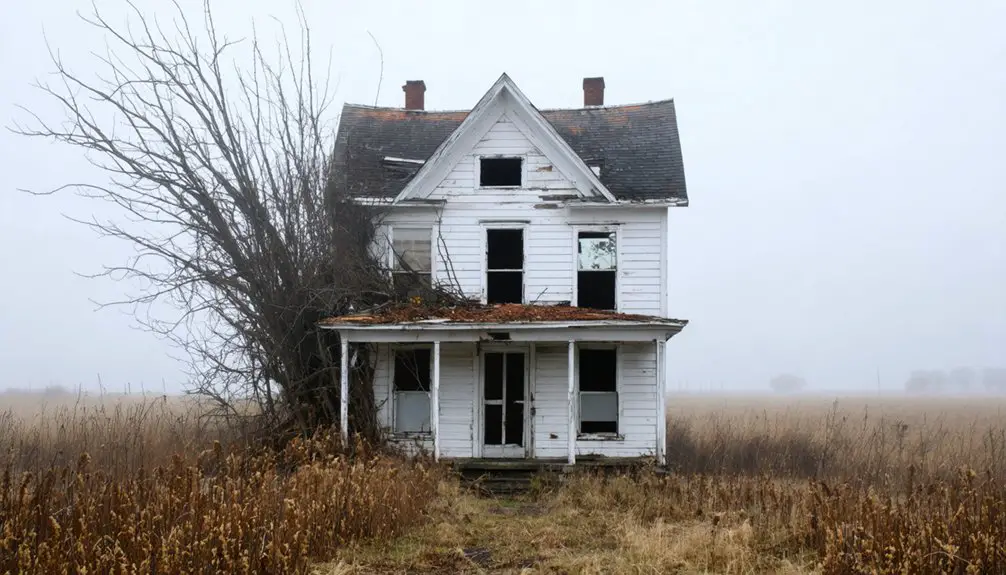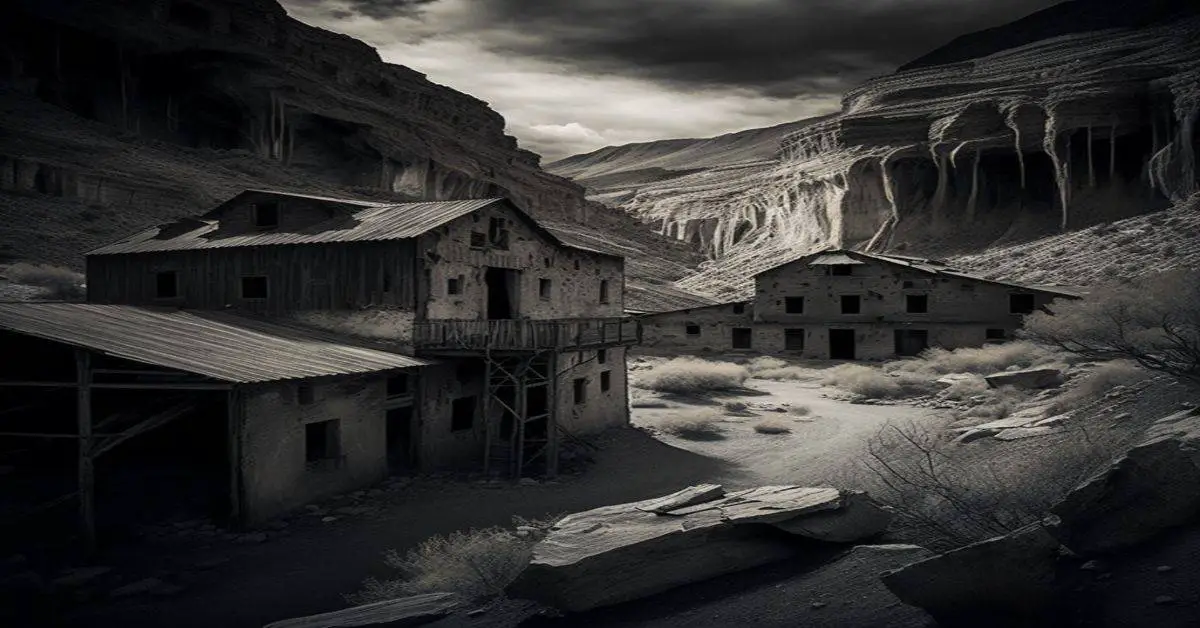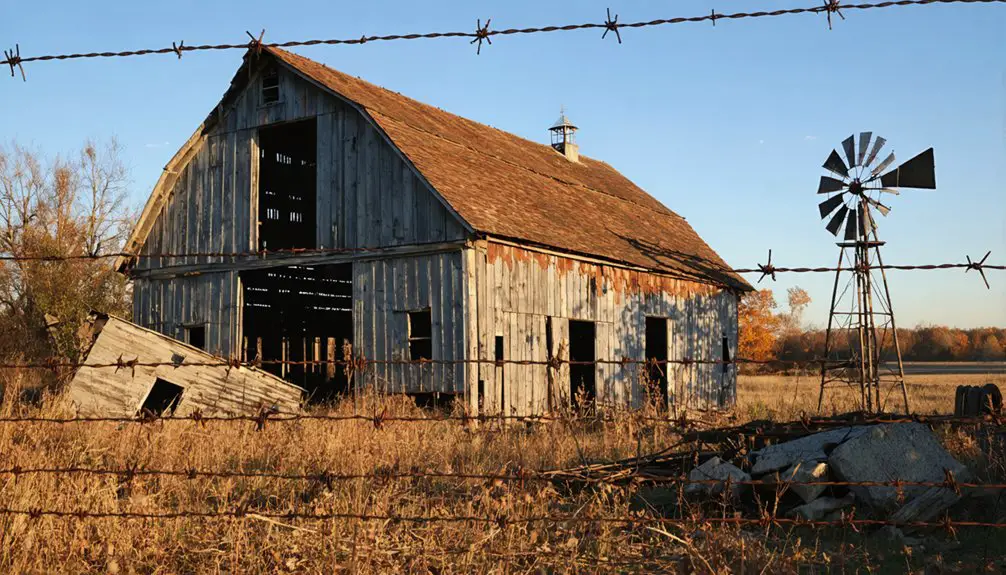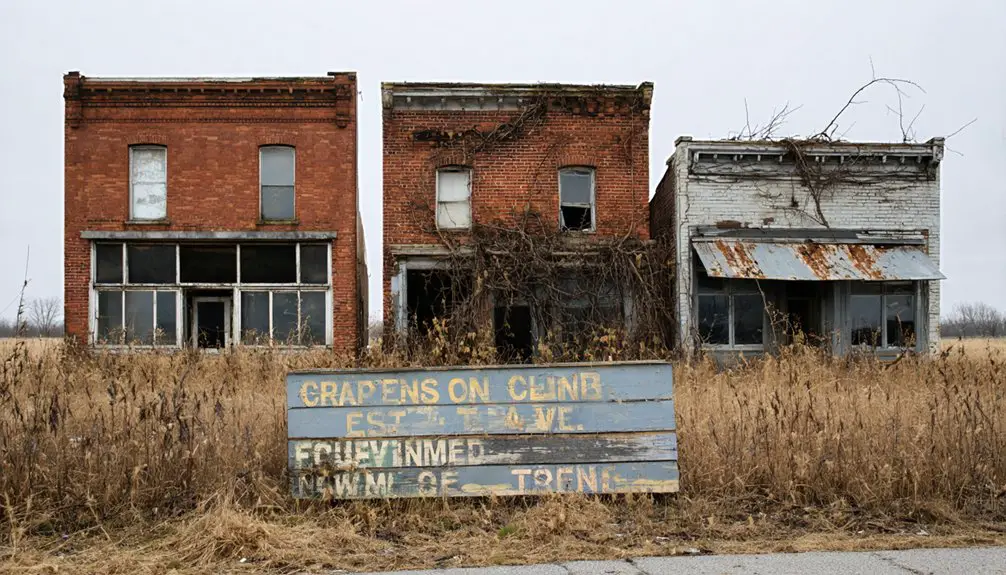You’ll find the ghost town of Hibernia in southeastern Ohio, where Irish immigrants established a thriving mining settlement in the late 1720s. Thomas Armstrong shaped the community in 1836, selling lots along the National Road and building essential infrastructure. The mines shipped 90,000 tons of iron ore in 1879 before closing in 1916, leaving behind abandoned shafts and the historic Carlisle Cemetery. These silent industrial ruins hold fascinating tales of America’s immigrant and mining heritage.
Key Takeaways
- Hibernia was founded as an Irish mining settlement in Ohio during the 1720s, established by immigrants fleeing the Irish famine.
- Thomas Armstrong developed the town in 1836, creating essential infrastructure including a school, hotel, and grocery store.
- The town thrived on iron ore mining, producing significant quantities until operations ceased in 1916 due to depleted resources.
- Social life centered around Irish heritage, with the community supporting mining families through shared customs and religious gatherings.
- Today, Hibernia exists as a ghost town with abandoned properties and industrial ruins, with Carlisle Cemetery remaining as historical evidence.
Origins of the Irish Mining Settlement
When severe famine struck Ireland in the late 1720s, waves of Irish immigrants sought refuge and opportunities in America, with some eventually establishing the mining settlement of Hibernia, Ohio.
You’ll find that these settlers chose the location strategically, drawn by rich mineral deposits and available land where they could build both a workplace and a cultural haven.
Like many Ulster Protestants who had previously migrated to America as skilled laborers, these Irish settlers brought valuable mining expertise to their new home.
The Irish Settlement took shape as mining operations expanded, with immigrants investing their experience from Ireland’s mines into this new venture.
Irish miners brought generations of mining expertise from their homeland, shaping Hibernia’s growing operations with time-tested knowledge and determination.
The settlers’ familiarity with mining operations stemmed from working in Wood’s copper mines back in Ireland.
For about £7 per person, as part of larger migration initiatives, these determined settlers created a thriving community centered on mining heritage.
They brought their Catholic faith, traditional customs, and strong work ethic, transforming Hibernia from a frontier outpost into a distinctive Irish mining town.
Thomas Armstrong’s Vision and Legacy
Among the early Irish settlers, Thomas Armstrong emerged as a pivotal figure who shaped Hibernia’s destiny. In 1836, you’ll find his ambitions reflected in how he strategically disposed of lots along the National Road, envisioning a thriving village that would serve both travelers and settlers.
He didn’t just sell land – he laid groundwork for essential community infrastructure including a school, hotel, grocery store, and repair shops.
His business interests also included a local blacksmith shop that served the growing community.
As Hibernia’s postmaster from 1849 to 1857, Armstrong’s leadership extended beyond land development. Though the settlement never incorporated, his practical planning established a service economy that defined the area.
Today, you can trace his legacy through regional historical records, family burial sites at Carlisle Cemetery, and the efforts of his descendants who continue preserving Hibernia’s rich cultural heritage. The hamlet of Hibernia eventually faded away, with complete disappearance by 1940s.
Mining Operations and Economic Growth
During its peak operations in 1879, Hibernia’s mines shipped an impressive 90,000 short tons of iron ore, establishing the region as an essential mineral source during America’s industrial expansion.
The mine reached a staggering production of 5 million tons of magnetite ore by the time it closed. You’ll find that mining techniques evolved as operations extended along a remarkable 2-mile vein, reaching depths of 1,500 feet by 1910. The mines’ economic sustainability relied heavily on efficient infrastructure, including the Hibernia Railroad Bridge and an extensive network of adits, shafts, and tipples for ore transportation.
Multiple mining companies competed in the region, driving employment and community growth throughout Rockaway Township. After the mine’s closure, the abandoned shafts became New Jersey’s largest hibernaculum for thousands of bats each winter.
While the mines closed in 1916 and exploratory drilling in the 1950s didn’t revive operations, you can still see evidence of this industrial heritage that once fueled local prosperity.
Daily Life in 19th Century Hibernia
If you’d visited a working-class family in 19th century Hibernia, you’d have found them living in a simple wood-framed house where women managed domestic duties like cooking on wood stoves while maintaining gardens for essential vegetables.
The town’s social fabric centered around the shared Irish heritage, with neighbors frequently helping each other during difficult times and gathering for traditional celebrations at the local church. Similar to practices at Slate Run Farm, families worked together threshing wheat and sharing labor-intensive farming tasks. When illness struck, residents had limited access to formal medical care, as there were only 115 Black women physicians among over 100,000 doctors nationwide in 1890.
The mining families’ daily routines revolved around the men’s dangerous work in the mines while their wives preserved food, made clothing from homespun fabrics, and relied on home remedies and local healers for medical care.
Working Class Family Life
Life in nineteenth-century Hibernia revolved around stark living conditions and clearly defined gender roles. You’d find your family living in a basic log cabin or frame house, typically on a 35 by 130-foot lot, without electricity, gas, or proper sanitation.
While men focused on mining or farming duties, women managed all household responsibilities, from preserving food to tending gardens and livestock.
Your daily routine would’ve centered on survival and self-sufficiency. As a working-class family, you’d face strict gender divisions in labor – women handling domestic duties while men tackled heavier outdoor work. Like early Cleveland settlers, families endured high mortality rates due to poor living conditions.
Your children would’ve contributed greatly, helping with family businesses or farms. Despite these challenging conditions, families often participated in community activities, including secret Underground Railroad operations, showing resilience beyond mere day-to-day survival. Similar to the Haines family in Stark County, some residents demonstrated their commitment to freedom by hiding fugitive slaves in their attics.
Mining Town Social Structure
While Irish immigrants faced discrimination in nineteenth-century Hibernia, they built strong community networks through organizations like the Ancient Order of Hibernians (AOH).
You’d find ethnic solidarity displayed through mutual aid societies that supported families during illness, unemployment, or death of a breadwinner. The local church served as more than a spiritual center – it was your hub for social gatherings and community organizing.
In this rigidly hierarchical society, you’d see clear divisions between mine owners, supervisors, and laborers.
The company controlled most aspects of daily life through ownership of housing and stores. Despite these restrictions, labor rights activism emerged through fraternal organizations, though members often faced show trials and punishment.
Your economic freedom was limited by credit systems that kept you dependent on the company store.
Irish Cultural Traditions
You’d find daily life in nineteenth-century Hibernia deeply rooted in traditional Irish customs, despite the hardships of mining town existence.
Your daily schedule would revolve around essential tasks, with women managing household duties while wearing characteristic shawls, and men handling outdoor chores in practical work clothes.
During precious moments of leisure, you’d join community festivals where Irish folklore and traditional music brought neighbors together, creating bonds through festive gatherings.
Storytelling practices preserved your heritage, as tales were shared around evening fires.
While you’d grow most of your food locally, relying heavily on potato-based meals, the community’s cultural resilience shone through shared folk remedies and seasonal celebrations that kept Irish traditions alive in this remote Ohio settlement.
Transportation and Railroad Impact
You’ll find that Hibernia’s railroad development mirrored Ohio’s broader rail expansion of the 1830s, when the state rapidly built nearly 3,000 miles of track to connect with major eastern trunk lines.
From the early dirt roads and wagon trails, the arrival of railroads transformed freight movement patterns, allowing local industries to ship goods more efficiently to national markets.
The rail lines that once served this now-ghost town integrated Hibernia into the state’s extensive transportation network, though today these tracks lie abandoned, marking the end of an era that saw Ohio become America’s most rail-connected state.
Railroad Lines and Operations
Ohio’s railroad expansion during the mid-1800s fundamentally shaped Hibernia’s transportation landscape, with the state boasting nearly 3,000 miles of track by 1860 – more than any other state at the time.
The Hibernia Mine Railroad, chartered in 1863, brought railroad technology and economic opportunities to this small community, connecting it to major rail networks that stretched from the East Coast to the Midwest.
You’ll find evidence of Hibernia’s rail heritage in structures like the Hibernia Mine Railroad Bridge, built in 1879. This metal truss bridge, which underwent several relocations, represents the era’s engineering prowess.
The railroad’s operations weren’t without challenges – early steam locomotives faced mechanical issues, and some, like the Hibernia engine of 1834, required extensive testing before entering service.
Early Transport Methods
Three primary modes of transportation shaped early life in Hibernia before the railroad era: horse-drawn wagons, river vessels, and canal boats.
You’d find wagon caravans organized by families and neighbors, led by master drivers who coordinated safety and logistics. They’d use pack saddles and hobbles to manage horses, carrying provisions like bread, jerk meat, and cheese for long journeys.
Before the canal system arrived, you’d pay about $125 per ton to move goods by horse-drawn transport. The Ohio and Erie Canal‘s completion in 1833 slashed those costs to $25 per ton.
While canal boats moved slowly at 3 miles per hour, they revolutionized north-south shipping. For river travel, you’d see everything from small canoes to large master vessels, often crafted from durable cypress wood.
Freight Movement Patterns
When railroad lines reached Hibernia in the late 1800s, they transformed the region’s freight movement patterns through three major rail connections: the Toledo & Ohio Central Railroad, the Big Four Railroad, and the Sandusky & Columbus Short Line Railroad.
You’d find a robust freight infrastructure centered around agricultural shipments, mining materials, and manufactured goods moving through the area’s rail stations.
The 1879 Hibernia Mine Railroad Bridge exemplified the town’s investment in specialized freight transport, particularly for heavy mining loads.
As time passed, you could witness the gradual economic decline as rail service diminished.
The abandoned and overgrown railroad right-of-way now stands as a reflection of Hibernia’s former significance, when freight movement by rail was the lifeblood of this once-thriving community.
Rise and Decline of a Mining Town
Located in the heart of Ohio, Hibernia emerged as a thriving iron ore mining town with roots stretching back to pre-Revolutionary times.
You’ll find evidence of community resilience in the town’s rapid growth, as multiple companies extracted ore from a vein stretching over two miles. Through economic adaptation, the town developed extensive rail networks and mining infrastructure, shipping an impressive 90,000 short tons of ore in 1879 alone.
The mining town’s spirit endured through massive growth, with rail networks transporting thousands of tons across its two-mile iron vein.
But by 1916, you’d witness Hibernia’s decline as mining operations ceased. The once-bustling industrial center fell silent as economically viable ore veins were exhausted.
Today, the abandoned mines serve a different purpose – they’ve become New Jersey’s largest bat hibernaculum, though their population has drastically decreased due to white-nose syndrome.
The historic 1879 railroad bridge stands as a silent reminder of Hibernia’s industrial past.
Notable Buildings and Landmarks
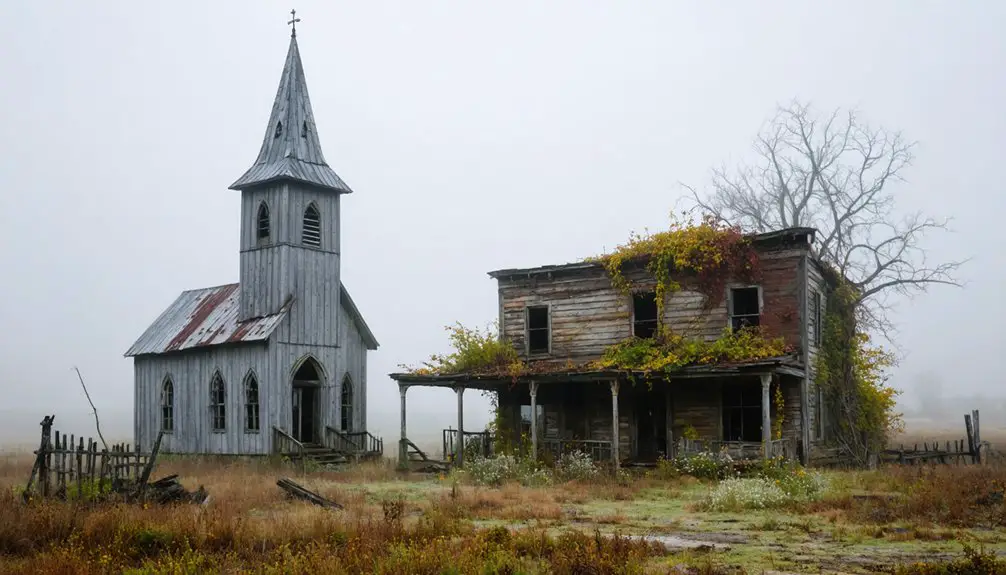
Today’s sole surviving landmark of Hibernia is the historic Carlisle Cemetery, nestled within the grounds of the modern Hibernia Apartment complex at US 40 and Noe Bixby Road.
The cemetery, one of the few remaining historical markers of this ghost town, contains weathered gravestones of early settlers and War of 1812 veterans, including Irish immigrant founder Thomas Armstrong.
While the original town buildings have vanished, Hibernia once boasted several essential structures along Big Walnut Creek.
You would’ve found a school, hotel, grocery store, wagon shop, and blacksmith shop serving the local community.
The town also maintained a post office from 1849 to 1857.
Though these buildings are gone, the preserved cemetery stands as a quiet memorial to Hibernia’s bygone era, fenced and protected amid modern suburban development.
The Carlisle Cemetery Chronicles
Dating back to 1810, the historic Carlisle Cemetery stands as one of Franklin County’s earliest burial grounds, predating the ghost town of Hibernia itself by several decades.
You’ll find this half-acre site near Noe Bixby Road and US 40, where approximately 512 souls rest, though only a dozen tombstones remain visible today.
The cemetery’s historical significance is marked by the presence of War of 1812 and Civil War veterans, along with town founder Thomas Armstrong and his family.
Cemetery preservation efforts have documented these remaining markers, which tell the story of early pioneer families and Irish immigrants who shaped the region.
While Hibernia has vanished into history, this burial ground serves as a vital physical link to the area’s rich heritage and the diverse community that once called it home.
Myths and Legends of Old Hibernia
While Hibernia’s physical remains have largely disappeared, the ghost town’s supernatural legacy continues to captivate visitors and locals alike.
You’ll find reports of UFO sightings above the highland cliffs, and ghostly apparitions near the ruins of the old munitions plant. The abandoned mining shafts, once essential to George Washington’s Continental Army, now echo with unexplained sounds and phantom figures of miners who met tragic ends.
The 1942 magazine bunker stands as a focal point for supernatural sightings, where you’ll experience sudden temperature drops and electronic interference.
Local legends speak of secret tunnels linking wartime operations, while stories persist of spectral soldiers and workers protecting hidden artifacts.
Even today, you might hear mysterious machinery sounds or encounter unseen presences along Hibernia’s remote trails.
Modern Remnants and Historical Significance
Along US 40 near the intersection of Noe Bixby Road and Big Walnut Creek, you’ll find the scattered remnants of Hibernia’s once-thriving industrial past.
This ghost town’s rich heritage dates back to 1764, when iron mining and production transformed the rugged highlands into a crucial wartime supplier. You can explore miles of overgrown trails leading to archaeological treasures: crumbling foundations, abandoned mine entrances, and ruins of an old munitions plant.
The industrial archaeology tells a compelling story of American ingenuity. Iron from Hibernia’s mines became tools, weapons, and cannonballs for Revolutionary War forces. Family-operated forges and furnaces passed their ironworking traditions through generations.
Today, while a few residents remain among the abandoned properties, Carlisle Cemetery and the vast industrial ruins stand as silent witnesses to Hibernia’s strategic importance in early American history.
Frequently Asked Questions
What Specific Minerals or Ores Were Extracted From the Hibernia Mines?
You won’t find coal extraction at Hibernia mines – they’re known for iron ore mining, specifically hematite and magnetite, producing over 90,000 short tons in New Jersey by 1879.
Did Any Major Accidents or Disasters Occur in the Mining Operations?
While you might think small mines were safer, historical accidents weren’t well documented in many rural operations. There’s no clear record of major disasters at Hibernia’s mines despite Ohio’s challenging mining safety history.
What Happened to the Original Mining Equipment and Infrastructure?
You’ll find no restored mining relics today – the equipment was abandoned, scavenged, or deteriorated. Most infrastructure like shafts were filled, while buildings fell to ruin or disappeared entirely.
Were There Any Native American Settlements in the Area Before Hibernia?
You’ll find historical settlements of multiple Native tribes in the Ohio River Valley area, including Shawnee, Delaware, and Seneca peoples who established communities there before being displaced by European-American expansion.
How Many Families Lived in Hibernia During Its Peak Population?
Like footprints in shifting sand, exact family demographics remain elusive. You won’t find precise records, but based on settlement patterns and comparative data, you’d estimate 20-30 families at peak population.
References
- https://ohioghosttowns.org/county-data-charts/
- https://kids.kiddle.co/List_of_ghost_towns_in_Ohio
- https://ohiohome.org/news/documents/GhostTowns.pdf
- https://ohioghosttowns.org/franklin-county/
- https://www.paranormalghostsociety.org/Hibernia Munitions Ruins.asp
- https://objectstudies.net/2015/04/15/the-rise-and-decline-of-woods-hibernia-halfpenny/
- https://www.encyclopedia.com/history/modern-europe/baltic-states-history/irish-americans
- https://en.wikipedia.org/wiki/Irish_Americans
- https://www.alternatehistory.com/forum/threads/nova-hibernia.529331/page-2
- http://quod.lib.umich.edu/e/eebo/A34852.0001.001/1:43?rgn=div1;view=fulltext
